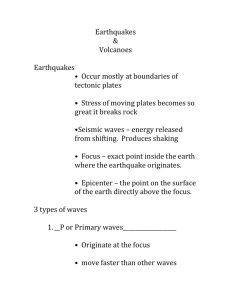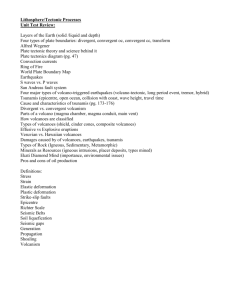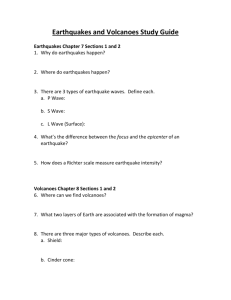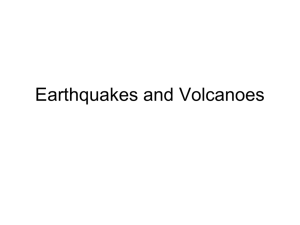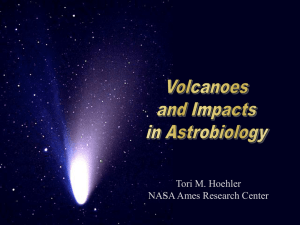PESUnit6PTEqVolcCycle18
advertisement
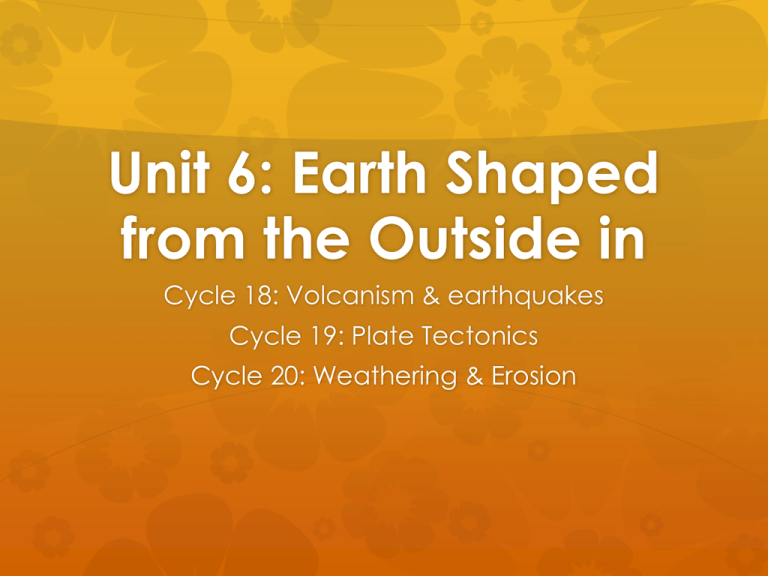
Unit 6: Earth Shaped from the Outside in Cycle 18: Volcanism & earthquakes Cycle 19: Plate Tectonics Cycle 20: Weathering & Erosion Connection to last unit… To deeply understand the processes that create rocks and minerals such as volcanism, weathering, pressue, etc. need more information about where in the world these things happen Connections beyond… Why learn it? So inherently cool! So dangerous, need to be prepared So relevent, in the news eery day impacting people around the world Class Opener Do mapping activity Are all the earthquakes and volcanoes evenly spaced randomly across earth’s surface? Why do earthquakes and volcanoes occur where they do? Volcanoes &Volcanism Volcanoes=the cone structure volcanism=movement of magma out of the earth Volcanism is caused by solid rock melting. Liquid rock is less dense and therefor rises Review: kinetic molecular theory of matter What 3 things cause rock to melt and rise? Increasing temperature Adding water Decreasing pressure Convergent Subduction Plate Boundary Volcanism Divergent Plate Boundary Volcanism Along plate boundaries & intra-plate areas Ring of Fire Mid-Ocean Ridge Hot Spots Volcanic Arcs Intra-Plate Volcanism (hotspots) •Convergent Subduction Volcanism –Plates are colliding with each other and subducting. lithosphere is being melted –Volcanism due to increased temps, water •Divergent Volcanism –Plates are ripping apart –Volcanism due to melting of asthenosphere due to less pressure from above •Intraplate Hotspot Volcanism –In middle of plates –Hot spot in mantle –plume rises towards the surface due to density difference Volcanic Structures As eruptive materials pile up at an opening a “volcano” forms Shield Composite Cinder Shield Volcano Shield Volcanco -Low angle slopes of 110 Largest volcano -Hawaii, Iceland -Generally on ocean floor -”quiet” eruption -made of basalt lava flows, no ash or pyroclastics -basaltic magma, low gas trapping Composite Cone/Stratovolcano Steeper slopes 10-25, taller than cinder cones. Smaller in height and width than shield volcanoes Cascades (Mt. St. Helens), Andes Volcanoes on continents over ocean-land subduction zones Alternating Explosive/quiet eruptions Built up by alternating layers of lava and pyroclastics Built over tens to hundreds of thousands of years Andesitic (or Granitic) composition magma, gas Cinder Cones Paricutin, Mexico, cinder cone soon after its birth in 1943 in a Mexican cornfield. Smallest volcanic features have large craters with steep slopes of 30-40 Paricutin, Mexico Generally forms on continents Explosive eruptions Built of pyroclastics (tephra/cinders) not lava flows. Generally short lived eruptions - weeks to a few years until the magma is degassed, then it solidifies in the pipe and flows form from the base What determines the shape, eruption type… What determines what kind of volcano forms? What determines what kind of eruptive materials occur? Type of eruption (explosive vs. quiet) What determines what kind of eruption occurs? The eruptive materials (lava vs. pyroclastics) The amount of pressure build up from trapped gas especially What determines the gas content and composition of the magma? What type of rocks are being melted, ocean floor, continental, both, asthenosphere, LOCATION Warning signs of impending eruption Earthquakes increase in frequency and strength Ash and gas increases Bulging of volcano side Dangers Pyroclastics: breathing, hit by it Lahars/mudflows: concrete flood Poisenous hot gases: can’t breath Pyroclastic flows: instant incineration 700km/hr (450mph) Deaths 1600-1982 Earth’s Layers Formed during early precambrian when earth was liquid rock all over 3 layers based on differences in composition 5 layers based on differences in “stiffness/fluidity” of material Crust, mantle, core Lithosphere, asthenosphere, lower mantle, outer core, inner core How do we know? Earthquakes! Seismic waves travel faster in denser materials. S-waves only travel through solids (both rigid and plastic) Inferences based on overall density calculations for earth, observations of surface materials, lava, and meteorites What is an Earthquake? Definition: sudden, strong shaking of the earth’s crust caused by release of energy Usually happens along faults Movement of rigid solid crust causes stress in rocks Rocks bend/stretch/com press/distort their shape Breaking point reached and rocks release energy and move along fault Go back to original “unbent” shape Can only occur in rigid solids of crust What are seismic waves? Body waves P waves S waves Primary wave Secondary Focus Focus Faster Arrive first Push-pull waves (compress/stretch rock, no shape change) Move through solids, liquids and gases Slower Arrive Second Up and down waves (change shape of rock) Only move through solids How do we measure earthquakes? Locating the epicenter of an earthquake The farther the station is from the epicenter, the greater the time is between the arrival of primary and secondary waves Need 3 stations Travel Time Graph 1. How long does it take the S & P wave each to travel 1000 mi? 2000 mi? 2. How much sooner will the P wave arrive at a seisograph station 1000 mi away from the earthquake location? 2000mi? 3. What is the general relationship between difference in arrival time between P & S wave and distance? 4. This graph can help geologists identify distance to earthquake epicenter but not… Direction! Earthquake dangers Falling objects Collapsing buildings Collapsing bridges, tunnels, etc. Fires (caused by broken gas lines etc.) Tsunamis near coast Interuption in medical and other emergency services due to debris and road closures Safety Precautions Inside: Drop, cover, hold on! Protect your head from falling objects, windows etc. Don’t try to get outside during shaking Be prepared for aftershocks Preparing your home for EQ safety Bolt bookcases etc. to wall No heavy objects above bed Know how to turn off gas & water Caught at the coast: Did the tide go out quickly? If you are seeing more of the bottom of the ocean than you should… Get to higher ground! Earthquake frequency and cause Earthquakes in New England? What causes earthquakes Most frequently at plate boundaries but can happen anywhere in plate, especially if there are faults already in rock


